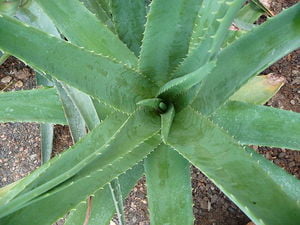Aloe Vera plants are so useful. From the well known healing powers for burns, to the lesser known help they give with digestion and allergies. But Growing an Aloe Vera plant requires a bit different care then your typical plant. Here are some tips Ive found help greatly.
Aloe Vera plants can be bought at most any garden center store. It can also be found in the wild. When choosing your aloe Vera plant, look for one that is large with good green leaves. However a smaller plant, even one with brownish or Gray leaves can be grown without problems. If you find a less then pleasing specimen, know that it is probably improper care that is causing the downfall, and a bit of love will perk it right up. If its leaves are brownish or grayish, it has been exposed to too much light, when you bring it home, place it in a area that receives no direct light and the leaves will perk back upright and turn green. My kitchen is a perfect area. The bathroom is a generally good area for aloe as well.
Aloe Vera grows great inside and out. Like most plants, it will grow better outside in indirect light. Inside it grows slower and must stay out of indirect light. It must be potted in well draining soil, preferably mixed with a bark or moss or even sand that helps promote proper draining. Aloe Vera’s are succulents, they store water and as such they need less water then typical plants. Much like cactus’s. Allowing the soil to dry between waterings can help promote growth. Proper drainage is essential or you can get root rot. Adding ammonium nitrate as a fertilizer once a year can be beneficial if the plant looks to be faltering or wilting.
Like many plants that one grows both indoors and out, it has different care tips. If your Aloe is outside, it needs to be in shade, as much as possible, under a tree works well. With well draining soil. It must be protected from freezing in the winter. Grows best in a southern area but it can be wintered in more northern areas if its mulched properly. However if it freezes, it will die. Outside, they grow nearly twice as fast as inside, so be prepared for a larger outdoors plant. It can grow up to two or three feet tall in optimal conditions. Perhaps bigger, but i haven’t seen it larger then that.
Propagation from an Aloe plant is done by offshoots. The mother plant will send up baby shoots, or pups near the base. When they get to be several inches tall and have a small root system of their own, cut the root from the mother plant and place it in its own pot. Water well then allow the plant to sit for a few weeks. This way the plant will establish good roots. If it looks to be wilting too much, some is to be expected, water it a small amount. It can flower and produce seeds,. which in turn can be planted however it is rare inside as conditions are rarely optimal for flowering. If yours does flower however, feel free to plant the seeds in a seedling pot and grow your second generation Aloe plants.The plant will need to be re-potted when it becomes root-bound. Unlike plants such as spider plants and Ivy’s which do well wen root-bound, the aloe can wilt or produce many pups when it runs low on root space. Using a larger pot with well draining soil will stop the mother plant from producing babies and continue its own growth.
There aren’t too many problems with Aloe plants. Most plants are easy to grow. No direct light, water once a week or less often if the conditions require and keeping the plant in a pot which allows room for the roots to breathe and grow the plant larger. However problems do occur. If your leaves are brown or grayish, the plant is getting too much light. Put it in a room with no direct sunlight, a kitchen often works well. If the leaves fall over or lay flat it is because of insufficient light. Move to a better lit area. IF the leaves are very thin, not the usual succulent thick and soft feeling, its because the plant is not getting enough water and is using up its own storage. Not very conductive if you want to use the aloe for its medicinal qualities.
To harvest your aloe leaves. clip or cut the leave as close to the base as possible. Using the leaves farthest outside because they are the oldest and therefore the strongest of the leaves. Cut it from the mother plant, then slice it in half width wise. Scrape out the clear goo and you are ready to use it. Store the goo in a glass container with a lid or use immediately. You must do this all in one step as the Aloe plant begins to heal itself very quickly by forming a scab over the cut end of the branch. If you wish to save the branch and take it with you. store in a sealed bag and re-cut when you are needed. This works well for taking the plant with you to say a game in the sun, a lake or beach or other summer activity that occurs outside and a sunburn might pop up.
Armed with a few basic ideas you should be able to grow a nice healthy aloe plant that has many wonderful qualities outside of being a lovely houseplant.


